

 VEHICLE RE-LICENCING
VEHICLE RE-LICENCING Customer Research & Data Analysis
OVERVIEW OF LICENCING PATTERNS
As at 30 July 2014 there were a total of 4,431,556 vehicles in the New Zealand fleet. Of these, 3,921,000 or 88% had a
current licence. While not all vehicles are required to be continuously licenced, half a million vehicles were unlicensed.
Overview of vehicle licence purchasing behaviour
700,000
This document brings together conclusions from the data analysis that has been performed to date and the results of the
second stage of customer research to present a rounded view of the current state of vehicle licencing in New Zealand.
600,000
Customer research was conducted in two stages. The first focused on digital reminders (email and text) and a vehicle
licencing calculator. The second stage which focused on the remaining initiatives. 18 individuals and 7 small to medium
500,000
businesses were interviewed for the second stage of research.
400,000
Licencing patterns across the light vehicle fleet (around 90% of the vehicle fleet) in 2013/2014 show that there a pattern to
licencing behaviour, with increases and decreased driven by distinct decision points. The key decision points are:
300,000
Series1
·
Cannot
Expiry
Expiry
Increase at 24 days prior to expiry as the MR1 Reminder is received
guarantee
approaching
passed
licence will arrive
·
200,000
Increase in face to face transactions at 7 days prior to expiry as customers may not receive their licence on time when
prior to expiry if
purchasing via the self service channel
MR1
completing
online
100,000
received
· Sharp increase at 2 days prior to expiry as expiry approaches
·
-
Sharp decrease at 2 days after expiry as the urgency has been removed.
-28
-26
-24
-22
-20
-18
-16
-14
-12
-10
-8
-6
-4
-2
0
2
4
6
8
10
12
14
16
18
20
22
24
26
28
Days
This pattern does not vary when we look at gender, age of registered person, age of vehicle, payment methods, or payment
channels.
LICENCING CALCULATOR
CUSTOMERS WITH MULTIPLE VEHICLES
ALTERNATIVE PROOF OF PURCHASE
In the research conducted by internal staff, participants
Participants independently suggested that an
There are approximately 2.5 million registered persons in the NZ fleet. Around 30 percent are registered in respect of more than
showed a strong demand for an alternative proof of
alternative method of determining the licencing fee
one vehicle. Internal customer research shows that some customers were enthusiastic about combining their vehicle payments
purchase, and identified this as the main barrier to
would be helpful. This was most often linked to the
as this would give them fewer transactions and less opportunity to be non-compliant. Convenience was another major factor.
purchasing a licence online.
desire to know the fee for a shorter or longer period
than those advertised on the form.
Other customers did not wish to combine their vehicles, mainly for budgeting reasons, or to keep personal and business vehicles
These participants stated that they were more likely to
separate. In general, customers wanted the ability and choice to either combine vehicles, or separate them further as they
Stage one of the research showed a strong demand
purchase online if the alternative proof of purchase was
chose.
for a licencing calculator when participants were
available.
specifically questioned. The combined results of
Companies or businesses are the registered person for nine percent of the vehicle fleet. Most small to medium businesses
both stages of research show a strong demand from
This result mirrors the research conducted in 2013,
preferred to separate re-licencing payments due to cash flow. Even if participants indicated that they would prefer a single
customers for a vehicle licencing calculator.
showing that there is a consistent and present demand
transaction, the overall licencing cost was considered a major factor.
for an alternative proof of purchase when transacting
under the Official Information Act 1982 through the self service channel.
EMAIL REMINDERS
BARRIER IDENTIFIED
Multiple transactions means a larger chance of
BARRIER IDENTIFIED
becoming uncompliant
Stage two of the research asked participants if they
Unwillingness to use self service channel close to expiry
felt they were given enough information to do the
date as no certainty of receiving label in time
INSIGHT
right thing. The majority of respondents suggested
that an email or text reminder would be useful.
INSIGHT
Provide the customers with a choice to combine
Digital reminders were mentioned as key customer
reminders and vehicle payments.
Introduce an alternative proof of purchase
wants or needs throughout the research. They were
Released
specially mentioned when participants were asked
ANTICIPATED BENEFITS
ANTICIPATED BENEFITS
to describe an ideal customer licencing experience,
·
Increase in online transactions
·
Increase in online transactions
and when asked to describe a system for automatic
(barrier removed for customer)
(barrier removed for customer)
renewal of the licence.
· Increase in customer satisfaction
· Increase in customer satisfaction
Stage one of the research also showed a strong
ANTICIPATED NEGATIVE CONSEQUENCES
demand for digital reminders from participants.
ANTICIPATED NEGATIVE CONSEQUENCES
None identified as result of research
None identified as result of research


 VEHICLE RE-LICENCING
VEHICLE RE-LICENCING Customer Research & Data Analysis
PAYMENT METHODS
· Seven of eight survey participants pay their other bills (such
as utilities, phone/internet, insurance and rent) via a digital
· There is strong support for an
Payment channel choice is out of
method.
automatic renewal payment
step with other bills
system.
· Convenience, ability to see bank balances and control over
Vehicle Licencing - Payment by Channel
·
payments were the main reasons for choosing a digital
Survey participants linked the
automatic renewal to the ability
2013/2014
payment method.
to pay for shorter licence periods
1982
(e.g. monthly) and with email or
1%
· Small to medium businesses had a strong tendency to
6%
text reminders.
purchase their licence at an agent using a cheque as this is
easier for them to account for.
Act
NZPOST
· Half of those currently paying late
20%
AA
or by non-digital methods (self-
VINZ
· In 2013/2014 53 percent of licences were purchased using
reported) stated they would pay
VTNZ
EFTPOS, and a further 19 percent by credit card. These
online and on time if their
ONLINE
58%
customers would be the target group to move to digital
9%
DIRECT CONNECT
payment methods
preferred method was available.
OTHER
5%
1%
·
This was because the licence
15 percent of customers in 2013/2014 paid by cash and 12
Half of the survey participants not currently online or on time indicated
would align with other bills or the
percent by cheque. It is unlikely that we be successful at
they would switch if their preferred payment method was offered
moving a large proportion of this group to a digital payment
customer’s lifestyle.
method.
Information
Vehicle Licences - Payment by Channel 2013/2014
Payment behaviour is driven by the structure of the current system
(combined channels)
900,000
800,000
In the 2013/2014 year, 73% of licence purchases
When asked how you could currently relicense, half the
700,000
were made via a face to face channel. This has been survey participants identified NZ Post.
600,000
a stable transaction rate for the last few years.
500,000
Face to Face
This suggests that NZ Post is seen as a key method or
Official
400,000
Digital
There is minimal movement between different
outlet for the Transport Agency, a conclusion that is
300,000
Other
payment channels, suggesting that without a change supported by previous research.
200,000
in services offered, there is little incentive for
100,000
the customers to alter their current behaviour.
It also supports the number of licencing transactions
-
-28
-26
-24
-22
-20
-18
-16
-14
-12
-10
-8
-6
-4
-2
0
2
4
6
8
10
12
14
16
18
20
22
24
26
28
(around 58%) which are completed via NZPost outlets.
BARRIER IDENTIFIED
The first significant boost in transaction
·
Payment through www.nzta.govt.nz is popular,
No instant proof of purchase (label) when transacting online
numbers occurs three weeks prior to expiry.
under
· Methods used to pay other bills not offered
This is presumably linked to customers
but it’s effectiveness is hindered by wait for a label
receiving the MR1 reminder notice, showing
INSIGHT
that to notice is a key touch point and call to
Vehicle Licencing - Payment by Channel 2013/2014
action for customers.
(excluding NZ Post)
· Increase prompts/reminders prior to expiry of current licence
120,000
Transactions through www.nzta.govt.nz are
· Allow customer to treat vehicle relicensing like their other bills –
the most popular renewal method until 7 days
offer wider payment choices.
100,000
prior the expiry date. This indicates that the
online channel is the most convenient for
ANTICIPATED BENEFITS
80,000
Released
AA
customers until they become concerned about
·
Increase in online transactions
VINZ
receiving their label prior to expiry date.
(barrier removed for customer)
60,000
VTNZ
·
ONLINE
Increase in customer satisfaction
Payment after the expiry date follows the same
·
DIRECT CONNECT
gentle declining curve for all channels,
Increase in on time compliance
40,000
OTHER
indicating that once the expiry date has
passed, channel accessibility does not
ANTICIPATED NEGATIVE CONSEQUENCES
20,000
influence purchasing behaviour as the driving
· May increase transaction and label volumes, impacting suppliers
motivator for purchasing, the expiry date, has
and the business
-
passed.
-28 -26 -24 -22 -20 -18 -16 -14 -12 -10
-8
-6
-4
-2
0
2
4
6
8
10
12
14
16
18
20
22
24
26
28


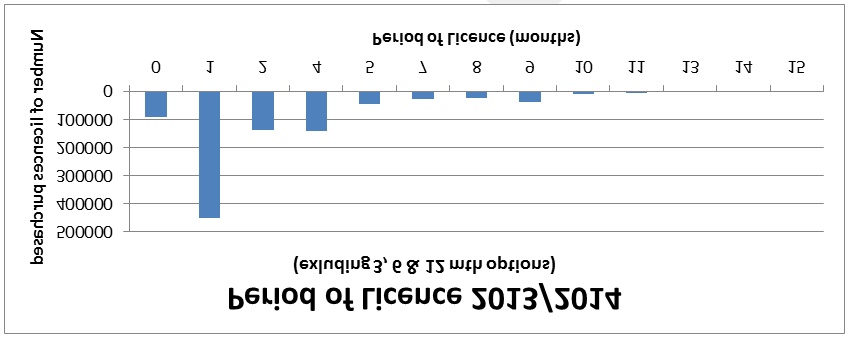
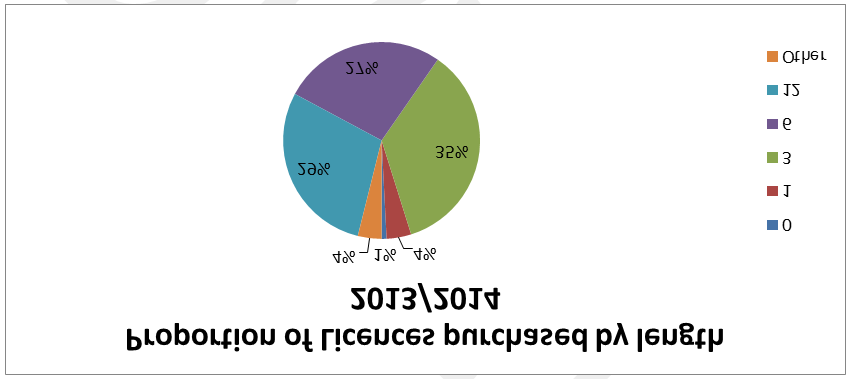
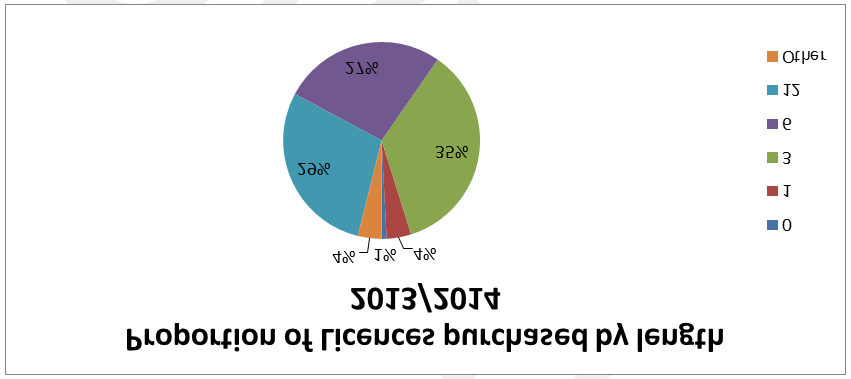
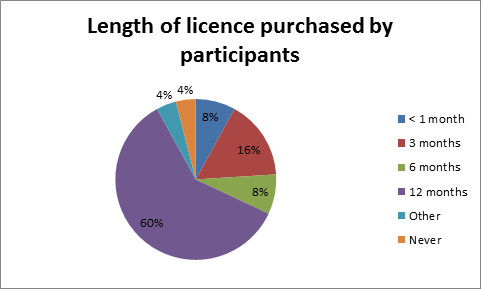
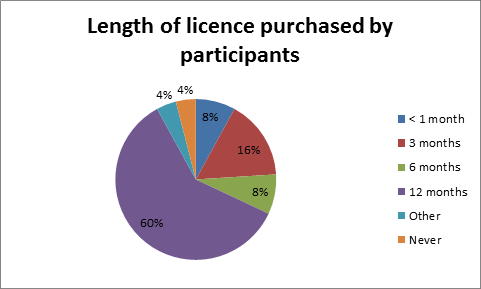 VEHICLE RE-LICENCING
VEHICLE RE-LICENCING Customer Research & Data Analysis
VARIABLE LICENCE PERIODS
Customers aren't aware of the
Customers prefer to purchase longer
BARRIER IDENTIFIED
MR 27 – Change of Expiry process
licences when possible
· Transaction does not occur at convenient time
· Limited awareness of current ability to change expiry date or
· Around half of the survey participants were satisfied with the current expiry
purchase non-standard licence periods
date of their licence, with nine stating that they would choose a different
expiry date.
1982
INSIGHT
· Aligning the expiry to a date that was more convenient for them was the
· Provide better access to change expiry date - combine MR1, MR1B
primary reason for changing (either to align with their WOF/service date, pay
Act
date, with other bills or away from expensive months).
and MR27 forms and offer exemption transaction online
· Allow customer to choose licence period by choosing an expiry date
·
60 percent of survey participants chose to licence for 12 months, and the
majority stated that they would prefer to licence for longer periods if possible
ANTICIPATED BENEFITS
as there was less risk of becoming uncompliant.
·
Increase in online transactions
Data analysis of the 2013/2014 year shows that 82.5% of licences are
·
The main reason for choosing the licence period was budgeting considerations
(barrier removed for customer)
purchased in the 3, 6 and 12 month periods specified on the reminder
or convenience. Around half would choose a different licence length.
· Increase in customer satisfaction
form. Less than 5% of licences are purchased for 1 month or less.
· Increase in on time compliance
·
Survey participants specifically linked shorter periods to the ability to direct
Customers during the recent Optimal survey were asked to indicate their
debit their payments on a regular basis.
ANTICIPATED NEGATIVE CONSEQUENCES
preferred licencing period on the reminder form. Of the 880 participants
·
There was minimal awareness amongst participants regarding the ability to
·
Information
52% said 12mths, 29% 6months, 11% chose 3 months, and 8% other or
May result in grouping of licence expiry dates (high and low volume
purchase a period other than those listed on the reminder form (3, 6, 12
did not indicate.
seasons for agents and NZTA staff)
months). This is reflected by the uptake of MR27 transactions. In 2013/2014
· May increase transaction and label volumes
only 7% of vehicle licencing transactions were for change of expiry.
The most popular licence period other than the standard advertised
· May increase customer opportunities to miss an expiry date
periods of 3, 6, 12 months is a 1 month licence.
The data supports the customer research conclusion that the majority of
customers prefer longer licencing periods.
What does the Future State look like – and what are the risks?
Official
Introducing automatic recurring payments will increase the number of shorter term licence periods being selected by customers, particularly if the initiative offers set
options (e.g. 1 month, 3 months, 6 months). The set periods (3, 6 and 12 months) appear to be chosen due to a lack of knowledge amongst customers of the ability to
the
self select a different period. By including this ability on the MR1 and in the online transaction, it is likely that we will see an increase in shorter licence periods.
Shorter licence periods represent a risk to the customer and to the business. The customer has more opportunities to be late or non-compliant while the business is
required to increase label production to meet the demand for shorter licence periods – particularly for automatic recurring payments.
This risk is mitigated by the self reported customer preference for a longer period when possible. It is likely that the opportunity to licence for a shorter period will only
under
be utilised by those who are financially constrained and not by the general public, thus reducing the movement from longer periods to those who truly need it.
By emphasising the ability to choose an expiry date, we may see an increase in renewals due during July as customers change their expiry date to take advantage of
ACC levy changes. As demonstrated below the distribution of purchases throughout the year is currently evenly spread.
Vehicle Licences - date of purchase 2013/2014
30,000
25,000
Released
20,000
15,000
# of licences
purchased
10,000
5,000
-
Jul 1
Jul 15
Jul 29
Aug 12
Aug 26
Sep 9
Sep 23
Oct 7
Oct 21
Nov 4
Nov 18
Dec 2
Dec 16
Dec 30
Jan 13
Jan 27
Feb 10
Feb 24
Mar 10
Mar 24
Apr 7
Apr 21
May 5
May 19
Jun 2
Jun 16
Jun 30
The trend is for a slight increase over the year of licences purchased. This is consistent with other data that shows year on year increases (from 2008) of 3mth licences purchased at the expense of 12mth licences. 6 month remains at a stable level.
Note that the increase in shorter licences may be linked to the higher ACC levy implemented in 2008 (an increase of approx $100). The Government has announced a decrease in the levy from July 2015 and this may result in a return to a longer licence period as it becomes more affordable.


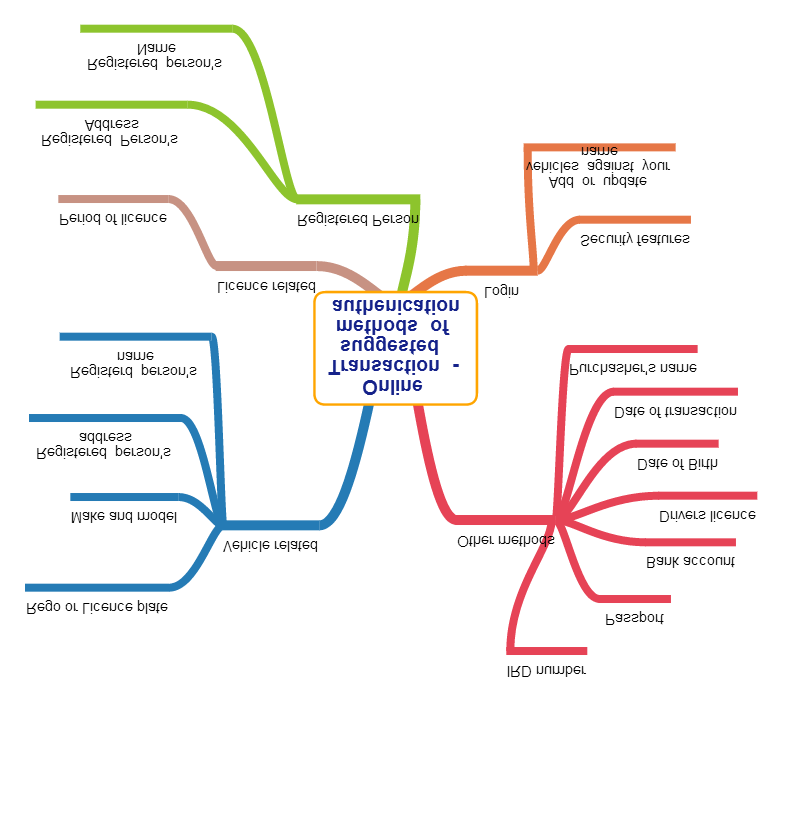
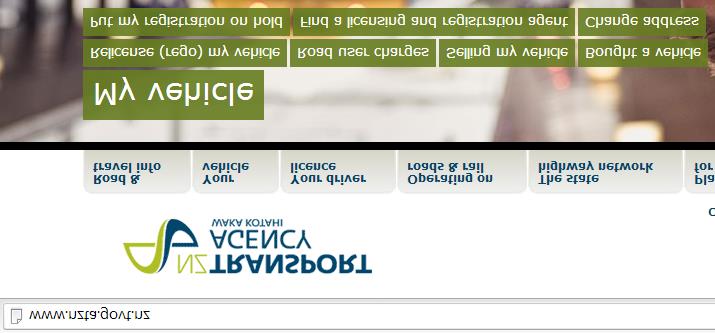



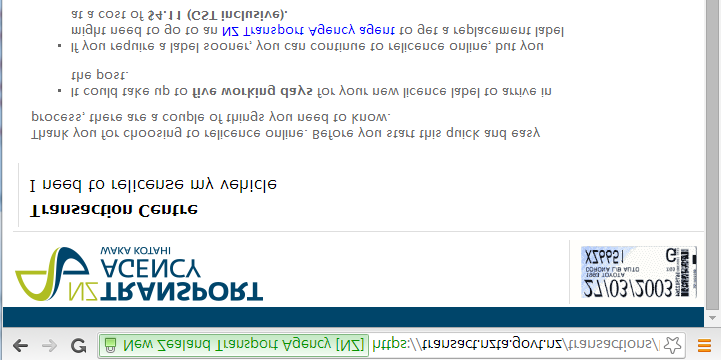 VEHICLE RE-LICENCING
VEHICLE RE-LICENCING Customer Research & Data Analysis
ONLINE EXPERIENCE
Transactions through
BARRIER IDENTIFIED
Vehicle Licencing - Digital Transactions
As reported to DIA's Result 10 group
· Difficult to access from smartphone
www.nzta.govt.nz are static
400,000
30.00%
· Authentication requirements prevent businesses from accessing the
Digital transaction volumes remain flat. In the last 5 350,000
transaction
25.00%
reported quarters, digital transactions have
300,000
increased by less than 40,000 transactions, or 2%.
1982
20.00%
250,000
INSIGHT
200,000
15.00%
# Digital Transactions
The increase between Q3 and Q4 2013 is attributed 150,000
% of Total Transactions
· Introduce a smartphone app
10.00%
to the inclusion of additional digital channels (direct
Act
100,000
· Simplify transaction layout and screens
connect, industry agents) to the reported figures.
5.00%
50,000
· Hold and return customer details
0
0.00%
Only 20% of the overall transaction volumes are
Q1 - Jul- Q2 - Oct- Q3 - Jan- Q4 - Apr- Q1 - Jul- Q2 - Oct- Q3 - Jan- Q4 - Apr-
Sept 2012 Dec 2012 Mar 2013 Jun 2013 Sep 2013 Dec 2013 Mar 2014 Jun 2014
ANTICIPATED BENEFITS
made through www.nzta.govt.nz.
·
Increase in online transactions
(barrier removed for customer)
Customers who visit the website complete
· Increase in customer satisfaction
· Increase in on time compliance
licencing related tasks
Visits to www.nzta.govt.nz
ANTICIPATED NEGATIVE CONSEQUENCES
Survey participants
· Inconsistent customer experience with other transactions offered by
Information
10
www.nzta.govt.nz
9
8
Most customers are happy to provide two or
7
6
more authentication tokens
5
Individual
4
Half of the customers interviewed were unable to identify any
3
Business
authentication tokens required to begin the online transaction.
2
Official
1
0
When asked what they would prefer, customers identified
Never
Once or less 2-3 times a
Monthly
Weekly
various identification tokens, with most customers indicating
a year
year
they were happy to provide more than one to begin the
But the current authentication tokens cause
the
The majority of survey participants who visited
transaction.
problems for businesses
www.nzta.govt.nz do so for vehicle licence related task
such as
Several participants suggested a login.
Small to medium businesses generally perceived the
· purchasing a licence,
current online process as ‘too hard’
·
Only three customers stated that the licence plate or “rego” was
changing ownership (registered person),
the only piece of information they expected to enter to begin
·
under
putting vehicles on hold (exemption) or
BUT
the transaction.
· getting information on licencing costs.
All customers want
Other reasons for visiting included searching for
Businesses expressed a desire to go online due to the
information about a drivers licence, looking for
convenience factor.
· Customers expressed a wish for a simple layout, with
information on local roading projects and investigating
clear, simple instructions.
drink driving ads.
Customers identified that barriers to going online were:
· Waiting for the label
· It was all about the convenience factor – customers
· Inability to licence due to being unable to provide the
liked the unobtrusive nature of websites that did not
correct identification tokens.
Released
require them to go out of their way to access the
service.
· Customers liked multiple options on how to access the
website, with several suggesting that an app for their
smart device would be easier to use than the website.


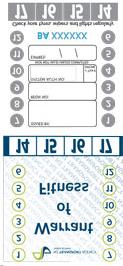
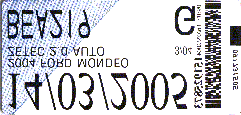
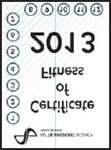 VEHICLE RE-LICENCING
VEHICLE RE-LICENCING Customer Research & Data Analysis
RELATIONSHIP BETWEEN WOF/COF INSPECTION AND VEHICLE RELICENCING
DATA ANALYSIS
In order to purchase a vehicle licence, a vehicle must have a current safety inspection, either a Warrant of Fitness (WOF) or
In the 2013/2014 year 2.4 million transactions were completed after the expiry date of the licence. Of these, only 14
a Certificate of Fitness (COF), dependant on the vehicle type and usage.
percent did not have a current safety inspection at the expiry date of the licence.
A customer is unable to purchase a vehicle licence if the WOF or COF has expired.
Less than 27,000 vehicles that paid late had their WOF/COF expiring on the same date as their licence – only 6 percent
of the total number of licences purchased that year, and 8 percent of those who licenced late.
This requirement is in place to encourage customers to maintain a safe and roadworthy vehicle at all times. The policy
1982
rationale behind this is that the Transport Agency’s focus is on promoting safe vehicles on the roads than collecting a “tax”.
WOF/COF Expiry in relation to Vehicle Licence Expiry
Late payers of vehicle licence 2013/2014 only
Decoupling the requirement to have a current safety inspection prior to allowing a customer to relicense a vehicle was
30,000
considered during the 2013 policy phase of the AVL project. It was decided not to recommend decoupling for the safety
Date of expiry
Act
reasons outlined above.
25,000
Anecdotally, one reason given for customers relicensing late is that the safety inspection is due close to, or on the same
d
20,000
ire
date as the vehicle licence. When there is unexpected repairs required on the vehicle to make it roadworthy, there is a
xp
e
delay in purchasing the licence, either because the customer must wait for work to be completed, or because the cost of
15,000
OF
F/C
the repairs means the customer no longer has the disposable income to purchase the licence.
f WO
10,000
# o
5,000
Information
-
36 35 34 33 32 31 30 29 28 27 26 25 24 23 22 21 20 19 18 17 16 15 14 13 12 11 10
9
8
7
6
5
4
3
2
1
Days WOF/COF expired prior to licence expiry date
Of those that paid late, 12 percent obtained a WOF or COF in the 28 days preceding their vehicle licence expiry.
There is a peak of vehicles gaining their WOF or COF the day after the licence expiry, but only 9 percent obtained their
Official
WOF/COF in the 28 days after licence expiry.
CUSTOMER RESEARCH
Date WOF/COF obtained
the
Late payers of vehicle licence 2013/2014 only
No specific questions were asked regarding the relationship between the WOF/COF and relicensing during either of the
25000
Date of expiry
two rounds of customer research.
WOFs were mentioned by customers in relation to the expiry date of their licence. Some customers wished to change
20000
their expiry date to align with their WOF due date or service date. This suggests that customers do not see this as a
under
barrier to purchasing their licence on time, and would help them to remember the expiry date. It was not clear however
d
that customers understood the requirement to have a current safety inspection in order to relicense.
taine 15000
b
o
OF
In the Optimal Survey 0.8% of participants suggested that we allow customers to re-licence with an expired WOF or
F/C
10000
include a WOF reminder with the MR1 reminder. These comments came from NZTA staff participants - there were no
f WO
# o
simiilar comments from external participants. This suggests that either customers are not aware of the requirement to
have a current safety inspection in order to re-licence their vehicle, or that they do not see this as a barrier to relicencing.
5000
CONCLUSION
Released
0
-28 -26 -24 -22 -20 -18 -16 -14 -12 -10
-8
-6
-4
-2
1
3
5
7
9
11
13
15
17
19
21
23
25
27
There is no specific causal link showing that the date of expiry of the WOF/COF significantly impacts the late payment of
Days before and after vehicle licence expiry
the vehicle licence. There may be many factors influencing the late payment of a vehicle licence, of which the expiry of a
0 is the day of exipry
WOF/COF may be one.
Document Outline

























